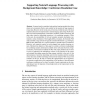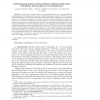150 search results - page 30 / 30 » Four Methods for Supervised Word Sense Disambiguation |
ICPR
2006
IEEE
14 years 6 months ago
2006
IEEE
It is a well documented fact that, for human readers, familiar text is more legible than unfamiliar text. Current-generation computer vision systems also are able to exploit some ...
SEMWEB
2010
Springer
13 years 2 months ago
2010
Springer
Systems based on statistical and machine learning methods have been shown to be extremely effective and scalable for the analysis of large amount of textual data. However, in the r...
JCST
2006
13 years 4 months ago
2006
Abstract A framework for dialectal Chinese speech recognition is proposed and studied, in which a relatively small dialectal Chinese (or in other words Chinese influenced by the na...
JMLR
2011
12 years 11 months ago
2011
We propose a framework MIC (Multiple Inclusion Criterion) for learning sparse models based on the information theoretic Minimum Description Length (MDL) principle. MIC provides an...
SIAMSC
2010
12 years 11 months ago
2010
In this paper we present HUND, a hypergraph-based unsymmetric nested dissection ordering algorithm for reducing the fill-in incurred during Gaussian elimination. HUND has several i...


